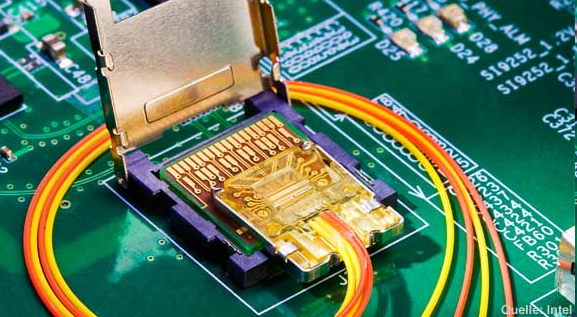Thunderbolt
Thunderbolt, also known by the project name Light Peak, is a technology developed by Intel and Apple for high-speed data transfer. Thunderbolt is an optical cable connection for data exchange between digital cameras and camcorders, players and recorders, displays, docking stations, computers, consumer devices, and more, which must be equipped with a Thunderbolt interface.
Thunderbolt features data rates of 10 Gbps in full duplex. That means 1.25 GB/s in both directions. In addition to the data rate of 10 Gbit/s, data rates of up to 40 Gbit/s are also specified. These specifications are directly related to the further developments under the name" Silicon Photonics Link".
The realized data rate of 10 Gbit/s does justice to many current application scenarios, from the data center to high- resolution 3D live transmissions for the home cinema. For example, a full-length HD movie can be transmitted via Thunderbolt in less than 30 seconds. The data rate applies to distances of up to 100 m without restrictions.
The Thunderbolt concept
The Thunderbolt concept consists of two controller chips: the Optical Module and the Light Peak Router. The Optical Module consists of two lasers for signal conversion into light pulses and two optical detectors for the receive lines. The Thunderbolt router provides protocol-based splitting between the individual signals. Thunderbolt is a multi-protocol connection with optical fiber over which different protocols can be multiplexed simultaneously and transmitted at the respective data rate. In principle, all fast interfaces used in PC technology such as the USB interface, DVI interface, FireWire, DisplayPort and PCI Express can be combined via a Thunderbolt connection. The user can also access networks with Gigabit Ethernet and Fibre Channel via a software adaptation.
As a connector concept, the first Thunderbolt prototypes had a type "A" USB connector with two optical fibers embedded in it. This connector can accommodate up to four optical fibers: Two for the transmit and two for the receive lines, 2x10 Gbit/s each. The concept calls for a small form factor connector, whose form factor is also suitable for installation in mobile devices. Thunderbolt is operated in daisy-chaining and is hot-swappable. High-speed transmission of data and HD video takes place over a single cable.
In the Thunderbolt 3 version, Thunderbolt supports 40 Gbps, using USB-C as the interface. The Thunderbolt 3 interface is used for data transfer between the computer and peripheral devices. It can tunnel the DisplayPort and PCI Express.
Thunderbolt could replace previous solutions like USB 3.1, Gigabit Ethernet, 10 Gigabit Ethernet, Firewire, High Definition Multimedia Interface( HDMI), PCI Express and DisplayPort, it could replace Serial ATA( SATA) and SAS interfaces, but it could also work with various Ethernet components and InfiniBand.


